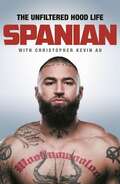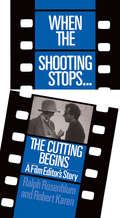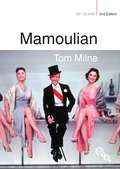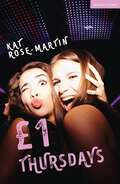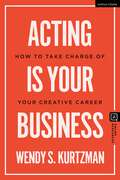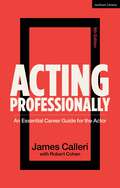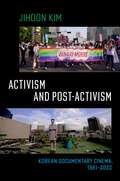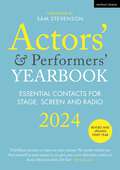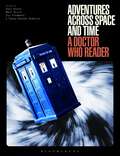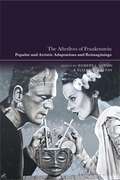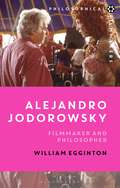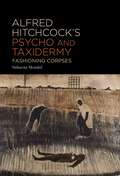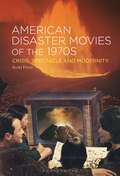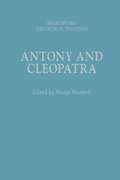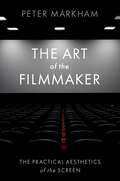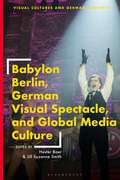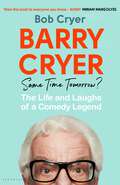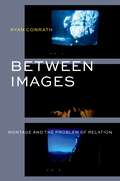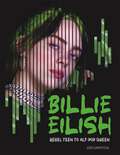- Table View
- List View
Spanian: The Unfiltered Hood Life
by SpanianBy the time he was twelve, Spanian knew he would follow his family's footsteps to become a career criminal. What followed was a decade-long string of brazen crimes and brutal violence: stabbings, ram-raids, drug runs and a notorious high school siege. Throughout the Sydney social housing enclaves of Redfern, Waterloo and Woolloomooloo, Spanian earned a reputation as one of the city's most flagrant crooks; armed with a boxcutter in one hand, and a syringe in the other.But it all came at a damning price: in the throes of heroin addiction and thirteen years wasted behind bars, Spanian became a longstanding resident of jails across New South Wales. There, he was embroiled in racial divisions, prison politics, and a vicious vortex of self-destruction, until music and books became an unlikely lifeline. Reading and rapping became new rituals, and a glistening light at the end of the tunnel. Released from Bathurst Correctional Centre in 2017 with newfound purpose, Spanian has since found viral fame and a sprawling, worldwide audience through hip-hop and his magnetic social media presence.This is the powerful, unflinching and high-octane memoir of how a young inner-city kid became Spanian. It gives unapologetic insight into the gritty socio-economic underbelly of Sydney city, the criminal justice system, and the correctional system. The story of Spanian provides hope that even the most stubborn cycles can be broken, and new dreams made.
When The Shooting Stops ... The Cutting Begins: A Film Editor's Story
by Ralph Rosenblum Robert KarenThe story of one of the most important and least-understood jobs in moviemaking-film editing-is here told by one of the wizards, Ralph Rosenblum, whose credentials include six Woody Allen films, as well as The Pawnbroker, The Producers, and Goodbye, Columbus. Rosenblum and journalist Robert Karen have written both a history of the profession and a personal account, a highly entertaining, instructive, and revelatory book that will make any reader a more aware movie-viewer.
Mamoulian (BFI Silver)
by Tom MilneThe great Armenian-American director Rouben Mamoulian (1897-1987) remains a favourite among film-makers, his films combining great technical originality with a uniquely poetic visual style. Mamoulian's technical innovations are evident from his first film, Applause (1923), in which he incorporated two separate soundtracks into one printing, thus overcoming the difficulty of sound levels which had frustrated the pioneer directors of 'talkies', and in Dr Jekyll and Mr Hyde (1931), in which he used synthetic sound painted directly onto the soundtrack. Such inventive solutions to film-making challenges were linked to Mamoulian's abiding sense of the magic of the cinema. Heused colour as a dramatic ingredient in the first three-strip Technicolour film, Becky Sharp (1935), and his musicals Summer Holiday (1948) and Silk Stockings (1957) were remarkable in their time for the way in which the dance was used to enhance the drama and to illuminate character. And for Garbo, in Queen Christina (1933) he created the framework for her greatest role. Tom Milne's classic study, first published in 1969, provides a film-by-film analysis of Mamoulian's career and challenges widespread critical assumptions about the director's oeuvre. In his foreword to this new edition, Geoff Andrew recognises Milne's careful and insightful analysis of Mamoulian's expressive and imaginative style and asks whether this unique director ought to be considered as an auteur. Andrew also pays tribute to Milne's elegant, witty and eclectic critical style and hails him as one the most important and influential British writers on film.TOM MILNE (1926-2005) was a leading British film critic, contributing to Sight & Sound, the Monthly Film Bulletin, The Observer, The Financial Times and The Times during his career. During the 1960s he worked at the British Film Institute as Associate Editor of Sight & Sound and Editor of The Monthly Film Bulletin. His other publications include a monograph on Joseph Losey (1967), a short study on the Danish director Carl Theodor Dreyer (1971) and an anthology of interviews and writings on Jean-Luc Godard (1972) that he edited and translated.Foreword by GEOFF ANDREW, Head of Film Programme at BFI Southbank, UK, and the author of several books including Nicholas Ray: Poet of Nightfall (BFI, 2004) and, in the BFI Film Classics series, volumes on Kieslowski's Three Colours Trilogy and Kiarostami's 10.
£1 Thursdays (Modern Plays)
by Kat Rose-MartinNewcastle, London, America. You can go anywhere, it's still the same old shit. People just getting by, in any way they know how. But I tell you what they don't have, they don't have a £1 Thursday!17-year-old Jen and Stacey are best friends. Since forever.Stacey always dreamed of being a dancer. And she's actually got the talent for it. Only her school career advisor hasn't even been to London, let alone heard of Urdang. Jen is smart. Like Oxbridge smart. But all 'smart' gives her is the ability to see that there's no use trying to change the story prewritten for her, growing up in an underfunded and forgotten Bradford in the 2010s.They only have one place they can escape to… Club Ocean on a Thursday night. Freedom for Jen and Stacey. A beautiful and hilarious coming-of-age story, Kat Rose-Martin's £1 Thursdays captures and celebrates the trials and tribulations of what it means to be young, Northern and working class, when for one Vodka-blurred second, you're allowed to forget everything and just dance.This edition was published to coincide with the world premiere at London's Finborough Theatre in November 2023.
Acting is Your Business: How to Take Charge of Your Creative Career (Introductions to Theatre)
by Wendy S. KurtzmanAfter training and studying for years, you've earned a degree: now what? How to get a job and have a career as an actor is the number one question facing emerging artists and one which this book answers for you.While performing arts schools do a great job of teaching how to act, most don't teach you how to launch and sustain a career. This book addresses this fundamental aspect of your creative journey, delivering a precise formula to help you organize the next chapter of your life. It helps you to find work and proactively build a career by providing the tools you'll need to connect with working professionals within the industry.If acting is your business, you must run it as a business. Positioning you as CEO of your own company, this book uses a boardroom table as a visual model. At that table are 7 key positions, each representing an area of action and expertise that you must understand to build a successful career. With worksheets and tools, supplemented throughout with interviews with industry professionals from North America, the UK and Europe, and Australia, and further supported by a companion website, this action plan will empower and equip you to achieve your career goals.
Acting Professionally: An Essential Career Guide for the Actor
by Professor Robert Cohen James CalleriFilled with essential advice and highlighting pitfalls to avoid, Acting Professionally gives a clear understanding of how acting careers are built and sustained. Now in its 9th edition, this book has become the leading book in the field since the first edition published in 1972.Critically, this new edition reflects the vital changes in the industry as a result of the Black Lives Matter, Time's Up and MeToo movements, and the Covid-19 pandemic. This new edition acknowledges and seeks to address the challenges of the industry often faced by actors when it comes to race, ethnicity, gender, diversity, and sexuality. It includes an extensive new section on the industry to reflect the 21st century, including signposting new resources and insights for the young actor, and considers the shifting landscape and opportunities offered by TV streaming, films, voiceover, internet, audiobooks, and podcasts. This 9th edition speaks to the changed landscape of unions, representation, self-tape auditioning and other best and up to date practices in the industry, ensuring that it's a book that's useful, relevant and accessible to every actor starting out today.
Activism and Post-activism: Korean Documentary Cinema, 1981--2022
by Jihoon KimActivism and Post-activism: Korean Documentary Cinema, 1981--2022 is a new book about nonfiction filmmaking in the private and independent sectors of South Korean cinema and media from the early 1980s to the present day. Drawing on the methodologies of documentary studies, experimental film and video, digital cinema, local discourses on independent documentary, and the literature on the social changes of South Korea, author Jihoon Kim historicizes the formation and development of Korean independent documentary in close dialogue with South Korea's social movements. From the 1980s mass anti-dictatorship movement to twenty-first-century labor issues, feminism, LGBT rights, environmental justice, and key events such as the Sewol Ferry disaster and the Candlelight Protests, Kim offers a comprehensive history of Korean social change documentaries in terms of their activist tradition. At the same time, Kim also maps out the formal and aesthetic divergences of twenty-first-century Korean documentary cinema beyond the activist tradition, while also demonstrating how they have inherited and dynamically renewed the tradition's engagement with contested reality and history. Making the tripartite connections between the socio-political history of South Korea, documentary's aesthetics and politics, and the shifting institutional and technological evolution of documentary production and distribution, the book argues that what is unique about this forty-year history of South Korean documentary cinema is the intensive and compressed coevolution of its two interlocked tendencies: activism and post-activism.
Actors’ and Performers’ Yearbook 2024
This well-established and respected directory supports actors in their training and search for work in theatre, film, TV, radio and comedy.It is the only directory to provide detailed information for each listing and specific advice on how to approach companies and individuals, saving hours of further research. From agents and casting directors to producing theatres, showreel companies, photographers and much more, this essential reference book editorially selects only the most relevant and reputable contacts for the industry.Covering training and working in theatre, film, radio, TV and comedy, it contains invaluable resources such as a casting calendar and articles on a range of topics from your social media profile to what drama schools are looking for to financial and tax issues.With the listings updated every year, the Actors' and Performers' Yearbook continues to be the go-to guide for help with auditions, interviews and securing/sustaining work within the industry.Actors' and Performers' Yearbook 2024 is fully updated and includes a newly commissioned article by actor Mark Weinman, a new foreword, 4 new interviews by casting director Sam Stevenson, giving timely advice in response to today's fast-changing industry landscape, and an article by Paterson Joseph.
Adventures Across Space and Time: A Doctor Who Reader
by Dr Paul Booth Matt Hills Tansy Rayner Roberts Joy PiedmontAdventures Across Space and Time brings together key academic, critic and fan writings about Doctor Who alongside newly-commissioned work addressing contemporary issues and debates to form a comprehensive guide to the wider Whoniverse.The perennially popular BBC series holds a unique place in the history of television and of TV fandom: the longest running science-fiction show, the series and its fan communities have tracked social and cultural changes over its 60 year lifetime. Adventures Across Space and Time presents classic writings on Who and its fandom by leading scholars including John Fiske, Henry Jenkins, John Tulloch and Matt Hills, but also represents writings and art by fans, including fans who went on to become showrunners, writers or even the Doctor himself, with contributions by Steven Moffat, Chris Chibnall, Douglas Adams and Peter Capaldi. This innovative anthology addresses Doctor Who's showrunners, Doctors, companions, enemies and collaborators as well as issues and debates around queer fandom, intersectionality, the 'wokeness' of the Doctor, fan media including websites, podcasts and vlogs, fan activism and questions of race and sexuality in relation to the show and its spin offs. It considers Doctor Who as a peculiarly British phenomenon but also one that has delighted, engaged and sometimes enraged viewers around the world.
The Afterlives of Frankenstein: Popular and Artistic Adaptations and Reimaginings
An exploration of the treatment of Mary Shelley's Frankenstein in popular art and culture, this book examines adaptations in film, comics, theatre, art, video-games and more, to illuminate how the novel's myth has evolved in the two centuries since its publication. Divided into four sections, The Afterlives of Frankenstein considers the cultural dialogues Mary Shelley's novel has engaged with in specific historical moments; the extraordinary examples of how Frankenstein has suffused our cultural consciousness; and how the Frankenstein myth has become something to play with, a locus for reinvention and imaginative interpretation. In the final part, artists respond to the Frankenstein legacy today, reintroducing it into cultural circulation in ways that speak creatively to current anxieties and concerns.Bringing together popular interventions that riff off Shelley's major themes, chapters survey such works as Frankenstein in Baghdad, Bob Dylan's recent “My Own Version of You”, the graphic novel series Destroyer with its Black cast of characters, Jane Louden's The Mummy!, the first Japanese translation of Frankenstein, “The New Creator”, the iconic Frankenstein mask and Kenneth Brannagh's Mary Shelley's Frankenstein film. A deep-dive into the crevasses of Frankenstein adaptation and lore, this volume offers compelling new directions for scholarship surrounding the novel through dynamic critical and creative responses to Shelley's original.
Alejandro Jodorowsky: Filmmaker and Philosopher (Philosophical Filmmakers)
by William EggintonAlejandro Jodorowsky is a force of nature. At 90 years old he is still making films and is a cultural phenomenon who has influenced other artists as disparate as John Waters and Yoko Ono. Although his body of work has long been considered disjointed and random, William Egginton claims that Jodorowsky's writings, theatre work and mime, and his films, along with the therapeutic practice he calls psychomagic, can all be tied together to form the philosophical programme that underpins his films. Incorporating surrealism and thinkers including Lacan, Kant, Hegel, and Žižek into his interpretation of Jodorowsky's work, Egginton shows how his diverse films are connected by interpretive practices with a fundamental similarity to Lacanian psychoanalysis. Using case studies of Jodorowsky's cult films, El Topo, Fando y Lis and Holy Mountain and more, this book provides a unique perspective on a filmmaker whose work has been notoriously difficult to analyse.
Alfred Hitchcock’s Psycho and Taxidermy: Fashioning Corpses
by Subarna MondalThere are numerous scholarly works on Alfred Hitchcock's Psycho (1960). Some of these works have explored its Gothic potentials. However, no detailed effort has yet been made to explore one of its major motifs – taxidermy. Taxidermy as an art of corporeal preservation has effectively been used in mainstream body horror films years after Psycho was released. Yet Psycho was one of the first films to explore its potentials in the Gothic genre at a time when it was relegated to a low form of art. Alfred Hitchcock's Psycho and Taxidermy focuses on taxidermy as a cultural practice in both Victorian and modern times and how it has been employed both metaphorically and literally in Hitchcock's films, especially Psycho. It also situates Psycho as a crucial film in the filmic continuum of body horrors where death and docility share a troubled relationship.
American Disaster Movies of the 1970s: Crisis, Spectacle and Modernity
by Dr. Scott FreerAmerican Disaster Movies of the 1970s is the first scholarly book dedicated to the disaster cycle that dominated American cinema and television in the 1970s.Through examining films such as Airport (1970), The Poseidon Adventure (1972), Two-Minute Warning (1976) and The Swarm (1978), alongside their historical contexts and American contemporaneous trends, the disaster cycle is treated as a time-bound phenomenon. This book further contextualises the cycle by drawing on the longer cultural history of modernist reactions to modern anxieties, including the widespread dependence on technology and corporate power. Each chapter considers cinematic precursors, such as the 'ark movie', and contemporaneous trends, such as New Hollywood, vigilante and blaxploitation films, as well as the immediate American context: the end of the civil rights and countercultural era, the Watergate crisis, and the defeat in Vietnam.As Scott Freer argues, the disaster movie is a modern, demotic form of tragedy that satisfies a taste for the macabre. It is also an aesthetic means for processing painful truths, and many of the dramatized themes anticipate present-day monstrosities of modernity.
Animate(d) Architecture: A Spatial Investigation of the Moving Image
At their peak, architectural marvels such as the Sagrada Família, the Tower of London, the Mosque–Cathedral of Córdoba, and the Eiffel tower, had a combined annual visit of almost 16.4 million people. The animated icebound castle in Disney’s (2019) Frozen had 116.4 million views, from one single YouTube trailer, in less than 24 hours. The spaces of such massively consumed animation have for generations informed the architectural imagination of people across the globe and from very early in their lives. Yet, not only have the architectural disciplines remained rather absent in the design of these massively consumed spaces, architectural theory has likewise failed to articulate a framework to approach the architecture of animation. To address this void, this book offers an interdisciplinary approach to survey the role of space in animation, including in creating humorous moments in early cartoon shorts, generating action and suspense in Japanese anime, and even stimulating erotic pleasure in pornographic Hentai. Exploring the imagined architecture of animation, from early motion picture to digital animation and from computer graphics to game engines, offers an analytical frame to reconceptualize space.
Antony and Cleopatra: Shakespeare: The Critical Tradition (Shakespeare: The Critical Tradition)
by Joseph Candido Professor Brian VickersThis new volume in the Shakespeare: The Critical Tradition series increases our knowledge of how Antony and Cleopatra has been received and understood by critics, editors and general readers. The volume provides, in separate sections, both critical opinions about the play across the centuries and an evaluation of their positions within and their impact on the reception of the play. The chronological arrangement of the text-excerpts engages the readers in a direct and unbiased dialogue, and the introduction offers a critical evaluation from a current stance, including modern theories and methods. This volume makes a major contribution to our understanding of the play and of the traditions of Shakespearean criticism surrounding it as they have developed from century to century.
Argentine Cinema and National Identity (Liverpool Latin American Studies #16)
by Carolina RochaAn Open Access edition of this book is available on the Liverpool University Press website and through Knowledge Unlatched.Argentine Cinema and National Identity covers the development of Argentine cinema since the late 1950s to the mid-1970s, a period that has been understudied. This essential cultural history delves on the dialect tradition versus modernity that was in place during those years and also comprises an examination of the political economy of film production as well as the different laws, including that implementing censorship that regulated this cultural industry. It also pays particular attention to two historical film genres: the historical film genre per se and the gauchesque, a genre based on outlaw gauchos that was crucial for nation-building in the nineteenth century. This volume investigates the way Argentine cinema positioned itself when facing the competition of glossy American films and resorted to the historical and gauchesque to bridge the stark divisions between the Argentine left and right in the late 1960s.
The Art of the Filmmaker: The Practical Aesthetics of the Screen
by Peter MarkhamThe Art of the Filmmaker: The Practical Aesthetics of the Screen explores the filmmaker's intention and method, their creation and capture of the fiction on the screen, and their formulation of the elements of the frame as a designed address to the audience. Positing 'practical aesthetics' as a resource of visual communication central to cinematic art, this book examines the concepts fundamental to the selective processes of the filmmaker and offers the reader highly informed textual analyses of specific films to explain the how and why of cinematic decision-making. After general consideration of language and cinema, Peter Markham sets out categories essential to the reader in their understanding of the filmmaker's art: dramatic narrative, elements before the lens, screen language, the shot, camera, editing, sound and music. Furthermore, Markham provides insight into how a comparison of the film with its screenplay can reveal the evolution of the filmmaker's storytelling strategies. This book also includes case studies of scenes and sequences from three films by contemporary filmmakers: Hereditary (Ari Aster), Moonlight (Barry Jenkins), and Nomadland (Chloe Zhao). Screenshots are used to illustrate the concepts articulated in the carefully constructed text. This book is intended for the student of filmmaking, its practitioners, students and scholars of film studies and film theory, for those in media studies and arts programs, and for lovers of movies.
Babylon Berlin, German Visual Spectacle, and Global Media Culture (Visual Cultures and German Contexts)
The essays in this collection address the German television series Babylon Berlin and explore its unique contribution to contemporary visual culture.Since its inception in 2017 the series, a neo-noir thriller set in Berlin in the final years of the Weimar republic, has reached audiences throughout Europe, Asia, and the Americas and has been met with both critical and popular acclaim. As a visual work rife with historical and contemporary citations Babylon Berlin offers its audience a panoramic view of politics, crime, culture, gender, and sexual relations in the German capital.Focusing especially on the intermedial and transhistorical dimensions of the series, across four parts-Babylon Berlin, Global Media and Fan Culture; The Look and Sound of Babylon Berlin; Representing Weimar History; and Weimar Intertexts-the volume brings together an interdisciplinary and international group of scholars to critically examine various facets of the show, including its aesthetic form and citation style, its representation of the history and politics of the late Weimar Republic, and its exemplary status as a blockbuster production of neoliberal media culture.Considering the series from the perspective of a variety of disciplines, Babylon Berlin, German Visual Spectacle, and Global Media Culture is essential reading for students of film, TV, media studies, and visual culture on German Studies, History, and European Studies programmes.
Barry Cryer: The Life and Laughs of a Comedy Legend
by Bob CryerForeword by Sandy Toksvig 'Give this book to everyone you know - NOW!' Miriam Margolyes'This is a joyous, uplifting book' Observer'He was so funny and such fun and here he is again in all his rib-tickling glory' Gyles Brandreth'I don't know how long I've got left … I don't even buy green bananas anymore' When the legendary comedian Barry Cryer died in January 2022, there was a vast outpouring of grief, appreciation and anecdotes – from the general public and fellow comics alike. Now, his son, Bob, is doing what Barry's humility did not allow: revealing the story of the man behind the jokes.This book is an ode both to Barry's incredible life and to the lessons he so generously imparted on the art of comedy during his sixty-year career. Stretching from the music halls of the fifties, via working alongside everyone from Morecambe and Wise to Kenny Everett and David Frost, and into more recent times as a stalwart of Radio 4's long-running I'm Sorry I Haven't a Clue, where he worked with Rob Brydon and David Mitchell among many others, this book is a hugely entertaining insight into the life of a true comedy legend. Bob also shares a range of exclusive material unique to the Cryer family – including family photos, memorabilia, oral recordings, interviews with friends and colleagues (among them Michael Palin and Eric Idle) – as well as Bob's own personal reflections on living and working with a comedy icon. Laced with candour, warmth and filled with his trademark humour, Barry Cryer: Same Time Tomorrow? is not just a wonderfully witty and affectionate biography of a father by a son, but a heartwarming insight into a vanishing era of comedy.
Between Images: Montage and the Problem of Relation
by Ryan ConrathIn the early days of moving pictures, filmmakers learned that the montage could be an effective tool to show changes in time or locale. Casablanca's iconic travel montage is mimicked by filmmakers to this day. Since its use in Rocky, the training montage has become a staple for sports films. In the 2004 film Team America, the song "Montage" is a meta explanation of the device's universal use and understanding. Its history and affects are studied and practiced by student and professional filmmakers alike. "Between Images proposes a unique theory of montage a technique of relation: a way of rethinking and reshaping how humans relateDLto ourselves and each other, to the material world, to the planet and its nonhuman inhabitants. Historically, film criticism has cast editing in one of several roles: as a device of spatiotemporal continuity to maintain the viewer's investment in the story-world; as an agent of disorder that confounds conventions of realism to prompt the viewer's intellectual engagement; and as an expressionistic device for augmenting the duration and combination of shots to leave a sensory impression. While not abandoning such accounts, this book ventures closer to the heart of montage by distinguishing the space between images as itself a powerful source of political, emotional, and aesthetic formation. Venturing into an "expanded field of montage," this study traces the cut and the splice across photographic and cinematic media, where the space between images becomes a setting for navigating and renegotiating the terms of relation, of the "being-with" that connects all forms of life. Between Images brings together a diverse cast of established and emerging film artistsDLHarun Farocki, Hito Steyerl, Steve McQueen, and Cauleen Smith, Da"ichi Saito, and Ja'Tovia Gary among othersDLto demonstrate the abiding capacity of cinema to effect change."
Billie Eilish: Rebel Teen to Alt-Pop Queen
by Mr Kevin PettmanThe must-have celebration of Billie Eilish, the most talked about teen on the planet.This book takes fans up close and personal with the teenage icon, charting Billie’s rise to superstardom, taking an in-depth look at her creativity, her unique musical, visual and fashion style, and exploring the causes – such as climate change and animal rights – that are close to her heart. It looks at her triumphs and her challenges, her attitudes and her ethos. Filled with brilliant photos and inspiring quotes, this is the ultimate book for Billie’s fans.
Black Sunday (Devil's Advocates)
by Martyn ConterioDespite its reputation as one of the greatest and most influential of all horror films, there is surprisingly little literature dedicated to Mario Bava's Black Sunday (1960), and this contribution to the Devil's Advocates series is the first single book dedicated to it. Martyn Conterio places the film in the historical context of being one of the first sound Italian horror films and how its success kick-started the Italian horror boom. The author considers the particularly Italian perspective on the gothic that the film pioneered and its fresh and pioneering approach to horror tropes such as the vampire and the witch and considers how the casting of British 'Scream Queen' Barbara Steele was crucial to the film's effectiveness and success.
The Blair Witch Project (Devil's Advocates)
by Peter TurnerFew films have had the influence and impact of The Blair Witch Project (1999). Its arrival was a horror cinema palette cleanser after a decade of serial killers and postmodern intertextuality, a bare bones 'found footage' trend setter. In this Devil's Advocate, Peter Turner tells the story of the film from his conception and production then provides a unique analysis of the techniques used, their appeal to audiences and the themes that helped make the film such an international hit, including the pionerring internet marketing.
Blood and Black Lace (Devil's Advocates)
by Roberto CurtiMario Bava’s Blood and Black Lace (1964) is a legendary title, and is commonly considered as the archetypal giallo. A murder mystery about a faceless and menacing killer stalking the premises of a luxurious fashion house in Rome, Blood and Black Lace set the rules for the genre: a masked, black-gloved killer, an emphasis on graphic violence, elaborate and suspenseful murder sequences. But Blood and Black Lace is first and foremost an exquisitely stylish film, full of gorgeous color schemes, elegant camerawork, and surrealistic imagery, testimony of Bava’s mastery and his status as an innovator within popular cinema. This book recollects Blood and Black Lace’s production history, putting it within the context of the Italian film industry of the period and includes plenty of previously unheard-of data. It analyzes its main narrative and stylistic aspects, including the groundbreaking prominence of violence and sadism and its use of color and lighting, as well as Bava’s irreverent approach to genre filmmaking and clever handling of the audience’s expectations by way of irony and pitch-black humor. The book also analyzes Blood and Black Lace’s place within Bava’s oeuvre, its historical impact on the giallo genre, and its influential status on future filmmakers.
The Blood on Satan's Claw (Devil's Advocates)
by David Evans-PowellWidely regarded as one of the foundational 'Unholy Trinity' of folk horror film, The Blood on Satan's Claw (1971) has been comparatively over-shadowed, if not maligned, when compared to Witchfinder General (1968) and The Wicker Man (1973). While those horror bedfellows are now accepted as classics of British cinema, Piers Haggard's film remains undervalued, ironically so, given that it was Haggard who coined the term 'folk horror' in relation to his film. In this Devil's Advocate, David Evans-Powell explores the place of the film in the wider context of the folk horror sub-genre; its use of a seventeenth-century setting (which it shares with contemporaries such as Witchfinder General and Cry of the Banshee) in contrast to the generic nineteenth-century locales of Hammer; the influences of contemporary counter-culture and youth movement on the film; the importance of localism and landscape; and the film as an expression of a wider contemporary crisis in English identity (which can also be perceived in Witchfinder General, and in contemporary TV serials such as Penda's Fen).
